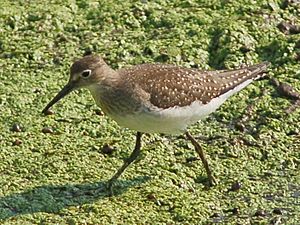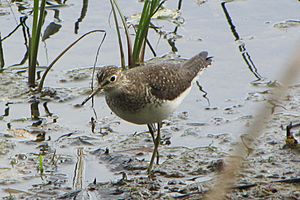Solitary sandpiper facts for kids
Quick facts for kids Solitary sandpiper |
|
|---|---|
 |
|
| Conservation status | |
| Scientific classification | |
 |
|
| Synonyms | |
|
Helodromas solitarius |
The solitary sandpiper (Tringa solitaria) is a small shorebird. It gets its name from the Latin word solitaria, which means "solitary" or "alone." This is because you often see these birds by themselves. The first part of its scientific name, Tringa, comes from an old name for a similar bird.
Contents
About the Solitary Sandpiper
This bird is about 18–23 cm (7.1–9.1 in) long. That's about the length of a standard pencil. Its wings can spread up to 50 cm (20 in) wide. It weighs between 31–65 g (1.1–2.3 oz), which is lighter than a small apple.
The solitary sandpiper looks a bit chunky. It has a dark green back and a grayish head and chest. Its belly is white. When it flies, you can easily see its dark wings and a dark patch on its tail. This dark tail patch helps tell it apart from a similar bird, the green sandpiper. The green sandpiper has a bright white tail patch. Both birds have brown wings with small light dots. They also have a soft but clear pattern on their neck and chest. When flying, the solitary sandpiper makes a special three-note whistle sound.
Where They Live and Travel
Solitary sandpipers live and have their babies in the woodlands of Alaska and Canada. They are migratory birds, which means they travel long distances. When winter comes, they fly south to Central and South America. Many of them spend winter in the Amazon River area and the Caribbean. Sometimes, a few solitary sandpipers might fly off course and end up in western Europe during summer or autumn.
Types of Solitary Sandpipers
There are two main types, or subspecies, of the solitary sandpiper:
- T. s. cinnamomea: These birds breed in Alaska and western Canada.
- T. s. solitaria: These birds breed from eastern British Columbia all the way to Labrador.
How They Behave
The solitary sandpiper is not a very social bird. You usually see it alone, especially when it's traveling. Sometimes, a few might gather in good places to find food. This bird loves fresh water. You can often find it in small ditches or ponds where other shorebirds might not go. They like places where they can see all around them.
Reproduction and Life Cycle
Female solitary sandpipers lay about 3 to 5 eggs. They don't build their own nests. Instead, they use old nests made by other songbirds, like thrushes, in trees. After the baby birds hatch, they are encouraged to jump out of the nest and onto the ground very soon.
What They Eat
Solitary sandpipers eat small invertebrates, which are creatures without backbones, like insects. Sometimes, they also eat small frogs. They find their food by picking it out of the mud around the edges of ponds and ditches. They move slowly and carefully as they search for their next meal.
See also
 In Spanish: Tigüiza para niños
In Spanish: Tigüiza para niños



